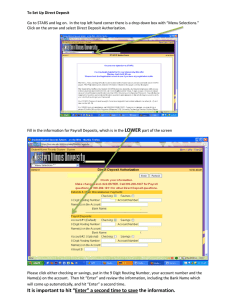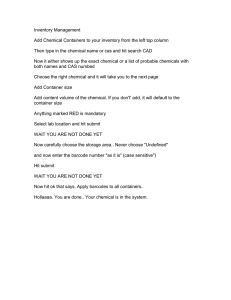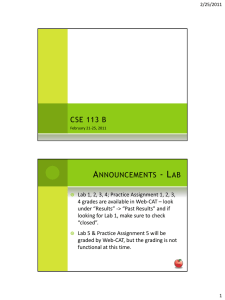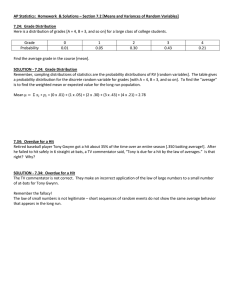A CSE 113 B NNOUNCEMENTS 10/5/2010
advertisement
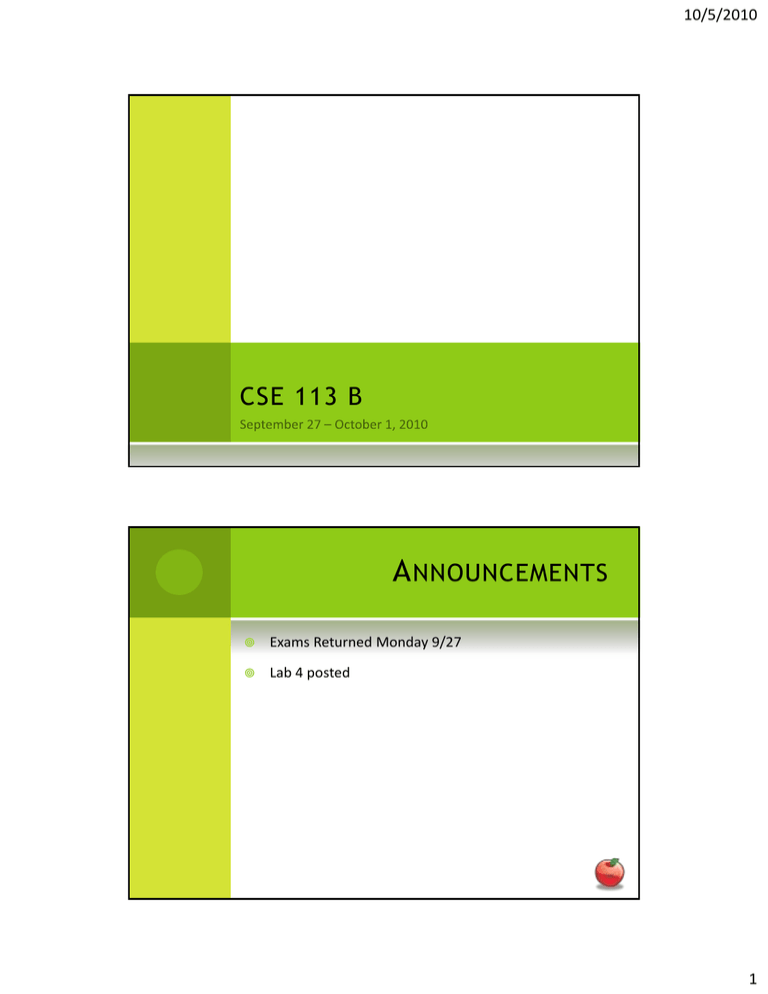
10/5/2010
CSE 113 B
A NNOUNCEMENTS
Exams Returned Monday 9/27
Lab 4 posted
1
10/5/2010
E XAM 1 S TATS
3
Grade Breakdown
Exam Statistics
A
21%
5%
Min
52
A-
Median
79
B+
22%
Average
78.84
B
22%
100
B-
12%
10.49
C+
8%
Max
Std Dev
C
4%
C-
3%
D
3%
F
0%
L AST Y EAR ’ S S TATS
4
Exam 1 Grades
SP 2010
Overall Letter
Grades - SP 2010
A
22%
A
14%
A-
14%
A-
14%
B+
14%
B+
10%
B
15%
B
12%
B-
10%
B-
9%
C+
6%
C+
7%
C
6%
C
6%
C-
3%
C-
2%
D
4%
D
3%
F
6%
F
11%
R
12%
2
10/5/2010
C ONSTRUCTORS
5
Constructors are special methods that are called
every time an object is created – they set up the
initial state of our objects.
Explicit constructors (ones that you can see in the
source code) look like this:
public NameOfClass()
{
}
C ONSTRUCTORS
6
A constructor has the same name as the name of
the class.
It does not have a return type.
If there is no explicit constructor in the source
code for a class, Java provides an implicit one
that you do not see in the source code, but is
inserted at compile time.
3
10/5/2010
C ARW ORLD C LASS
7
Looking at the constructor of CarWorld, we can
see a method call that looks like this:
super(x, y, z)
Here, we are not calling a method called super,
but rather super is a keyword that indicates the
superclass. In this case, we are calling the
superclass’ constructor.
A DDING OBJECTS AT STARTUP
8
We can add objects to the world when it is created by
calling the addObject method from the world.
Example
addObject(new Car(), 34, 56);
Note that we need to create a new Car object to add by
using the expression new Car(). This expression creates
an object and calls the constructor of that object.
The numbers that follow are the x and y coordinates of
where we would like the object to be in the world.
4
10/5/2010
9
C HANGES TO P ROGRAM
10
Scenario should stop after we hit a certain
number of obstacles.
5
10/5/2010
Q UESTION
11
What do we need to do?
A NSWER
12
First, recognize that we’ve hit something:
if(hit barrel)
{
//Q: What do we do?
}
6
10/5/2010
13
if(hit barrel)
{
turn away
note that we hit another barrel
if(we’ve hit too many)
{
stop scenario
}
}
14
C ODE THAT WILL RUN ( BUT
NOT PERFECTLY )
if(true) //hit barrel
{
turn(45);
//note that we hit another barrel
if(false) //we’ve hit too many
{
//stop scenario
}
}
7
10/5/2010
N EXT S TEPS
15
Fill in code to recognize the collision of the car
with the barrel.
Fill in the code to stop the scenario.
Q UESTION
16
How do we figure out if we’ve hit too many?
8
10/5/2010
VARIABLES
17
18
Variables are used to store information.
Instance variables store information important to
the entire class.
I NSTANCE VARIABLE S YNTAX
9
10/5/2010
VARIABLES
19
After we declare the instance variables, it is good practice
to give it an initial value.
We would give an instance variable and initial value in the
constructor of the class.
Example
_barrelsHit = 0;
Note that this expression uses the assignment operator
(=) and takes the values on the right hand side and assigns
them to the variable on the left hand side.
I F - STATEMENTS
20
We have been working a lot with if-statements to
determine choices in our programs. If we look at our
program execution with if-statements, it would look
something like this:
10
10/5/2010
M ORE
21
We could create choice in programs that looks
like this:
M ORE
22
WAYS TO CHOOSE
WAYS TO CHOOSE
That would be the notion of a choice when there
is a definitive path when a condition is true and
another path when the condition is false.
In order to do this type of choice in code, we
would need to use if-else statements instead of
just if-statements.
11
10/5/2010
I F - ELSE S YNTAX
23
if( /*boolean expression*/ )
{
//code to be executed if boolean expression is true
}
else
{
//code to be executed if boolean expression is false
}
12
